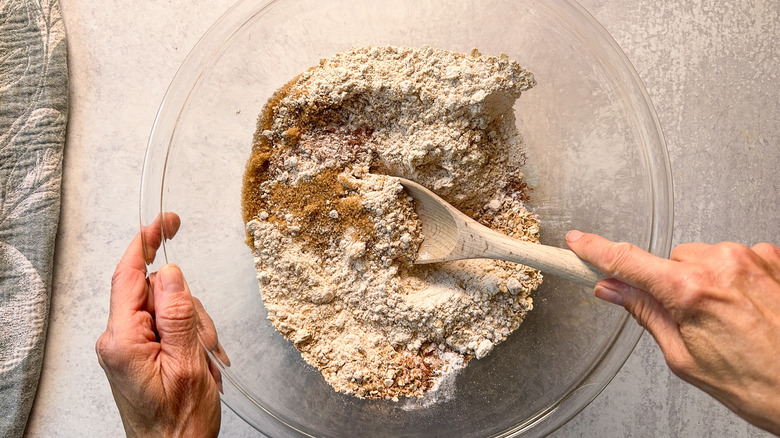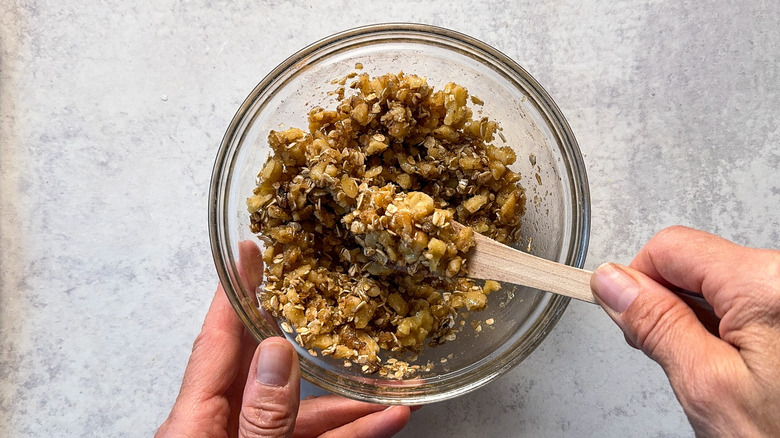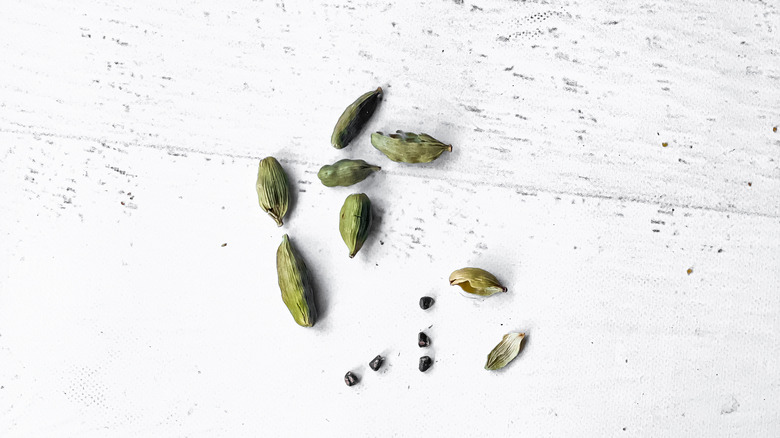Rhubarb And Cardamom Oat Muffins Recipe
If your garden has given you a bounty of ruby-hued rhubarb, think beyond pies and try highlighting it in some moist and nutritious spiced muffins. These rhubarb and cardamom oat muffins — courtesy of recipe developer Julie Kinnaird – have a nutty flavor and chewy bite from a combination of quick oats and oat flour, warm spice from ground cardamom, and a crunchy streusel topping made with walnuts and brown sugar. The tart and citrusy flavor of fresh rhubarb is a perfect contrast to the rich flavor of these easy muffins.
The batter comes together quickly and can even be made a day ahead, refrigerated, and then scooped and baked first thing in the morning for a delicious breakfast treat. These muffins will also freeze well once baked, so make a double batch to have on hand whenever you want the summery flavor of rhubarb. These muffins are naturally gluten-free — just be sure to look for gluten-free quick oats on your grocer's shelf. If you haven't baked with cardamom before, you are sure to enjoy this aromatic spice that blends perfectly with a touch of cinnamon and vanilla.
Gather the rhubarb and cardamom oat muffins ingredients
To make these muffins, you will want to use fresh rhubarb stalks. Frozen sliced rhubarb will also work if fresh is not available. The rhubarb is tossed with a bit of light brown sugar, ground cardamom and cinnamon before you add it to the batter. Oat flour and quick-cooking oats form the base of the muffins. Flax meal helps add structure, the muffins are sweetened with additional brown sugar, and both baking powder and baking soda are used for leavening. Sea salt and the zest of a small lemon add flavor to the dry ingredients. Large eggs, canola oil, and oat milk moisten the batter, and vanilla extract adds additional flavor and sweetness. A streusel topping is made from raw walnuts, more brown sugar and oats, butter, and additional cinnamon, cardamom, and sea salt.
Step 1: Preheat the oven
Preheat the oven to 350 F.
Step 2: Prepare a muffin tin
Line a 12-cup muffin tin with paper liners.
Step 3: Slice the rhubarb
Cut the rhubarb stalks crosswise into ¼-inch slices.
Step 4: Marinate the rhubarb
In a medium bowl, combine the rhubarb with 2 tablespoons brown sugar, ½ teaspoon cinnamon, and ¼ teaspoon cardamom. Set aside.
Step 5: Whisk together the liquid ingredients
In a large mixing bowl, whisk together the eggs, canola oil, oat milk, and vanilla.
Step 6: Combine the dry ingredients
In a separate bowl, combine the oat flour, oats, flax, baking powder, baking soda, salt, and lemon zest with the remaining brown sugar, cinnamon, and cardamom.
Step 7: Add the rhubarb
Add the rhubarb to the flour mixture, tossing to coat.
Step 8: Add the rhubarb and dry ingredients to the egg mixture
Add the rhubarb and dry ingredients to the egg mixture, stirring until the mixture is just combined and no dry spots remain.
Step 9: Scoop the batter into the muffin papers
Use a large ice cream scoop or spoon to fill the muffin papers two-thirds full.
Step 10: Make the streusel
To make the streusel, combine all of the ingredients in a small bowl and mix well.
Step 11: Add the streusel to the muffin batter
Divide the streusel evenly between the muffin batter tops.
Step 12: Bake the muffins
Bake the muffins for 25–30 minutes, until a tester inserted in the center comes out clean.
Step 13: Cool the muffins
Cool the muffins for 15 minutes in the pan, then remove and finish cooling on a rack.
Rhubarb and Cardamom Oat Muffins Recipe
These hearty oat muffins honor fresh summer rhubarb by mixing it with the warming spices of cinnamon and cardamom. The muffins are naturally gluten-free, too.

Ingredients
- For the muffins
- 2 large stalks rhubarb
- ¾ cup light brown sugar, packed, divided
- 1 ½ teaspoons ground cinnamon, divided
- ¾ teaspoon ground cardamom, divided
- 3 large eggs, room temperature
- ½ cup canola oil
- ½ cup oat milk
- 2 teaspoons vanilla extract
- 2 cups oat flour
- ¾ cup quick oats
- 2 tablespoons ground flax meal
- 2 teaspoons baking powder
- 1 teaspoon baking soda
- ½ teaspoon salt
- 1 small lemon, finely zested
- For the streusel
- ½ cup chopped raw walnuts
- 3 tablespoons light brown sugar
- 3 tablespoons quick oats
- 2 tablespoons unsalted butter, melted
- ¼ teaspoon ground cinnamon
- ¼ teaspoon ground cardamom
- ¼ teaspoon salt
Directions
- Preheat the oven to 350 F.
- Line a 12-cup muffin tin with paper liners
- Cut the rhubarb stalks crosswise into ¼-inch slices.
- In a medium bowl, combine the rhubarb with 2 tablespoons brown sugar, ½ teaspoon cinnamon, and ¼ teaspoon cardamom. Set aside.
- In a large mixing bowl, whisk together the eggs, canola oil, oat milk, and vanilla.
- In a separate bowl, combine the oat flour, oats, flax, baking powder, baking soda, salt, and lemon zest with the remaining brown sugar, cinnamon, and cardamom.
- Add the rhubarb to the flour mixture, tossing to coat.
- Add the rhubarb and dry ingredients to the egg mixture, stirring until the mixture is just combined and no dry spots remain.
- Use a large ice cream scoop or spoon to fill the muffin papers two-thirds full.
- To make the streusel, combine all of the ingredients in a small bowl and mix well.
- Divide the streusel evenly between the muffin batter tops.
- Bake the muffins for 25–30 minutes, until a tester inserted in the center comes out clean.
- Cool the muffins for 15 minutes in the pan, then remove and finish cooling on a rack.
Nutrition
| Calories per Serving | 320 |
| Total Fat | 18.1 g |
| Saturated Fat | 3.1 g |
| Trans Fat | 0.0 g |
| Cholesterol | 52.6 mg |
| Total Carbohydrates | 34.6 g |
| Dietary Fiber | 3.0 g |
| Total Sugars | 16.8 g |
| Sodium | 227.8 mg |
| Protein | 6.5 g |
What can you use as a substitution for oat flour?
Kinnaird created this recipe to highlight the soft, tender texture and nutty flavor that oat flour yields in baked goods. However, if you find yourself short on oat flour or just want to switch in something different, there are some reliable substitutions. Because oat flour tends to absorb a lot of liquid, the amounts of other flours need to be adjusted slightly. If you are not concerned about gluten content, you can try using ¾ cup all-purpose or wheat flour for each cup of oat flour.
Rye flour is another interesting substitution that you can add in the same ratio as the wheat, but it will tend to produce a heavier-textured muffin and will have a distinctive rye flavor (which Kinnaird things works well with rhubarb). Buckwheat or rice flour can be swapped in with a 1:1 ratio for the oat flour if you want to keep the muffins gluten-free. Lastly, try using a blend of oat and almond flour together for a nutty twist on this recipe!
What are the nutritional benefits of rhubarb?
Rhubarb is a complex plant with four components — the roots, bulb, stalks, and leaves. Only the red and green stalks of the plant are edible, and even these require considerable treatment to be considered delicious by most. If you don't have your own patch of rhubarb growing around your yard, it can often be tricky to find in grocery stores. But, farmers markets often have a plethora of this garden vegetable from early spring through early fall.
Rhubarb is often only associated with sweet desserts, such as pies, cobblers, or sauces, that tame its astringency with plenty of sugar. While these are not the most healthful preparations, rhubarb does offer a variety of benefits, such as high doses of vitamin K and vitamin C. The stringy, almost celery-like stalks of rhubarb also contain lots of fiber and are a significant source of antioxidants.
What is cardamom, and what does it tast like?
Cardamom is a potent spice used in a variety of cuisines, from Indian to Middle Eastern and Scandinavian. Cardamom seeds come from small, thin pods that are grown on the plants. The pods come in both green and black varieties. Green cardamom tends to grow in tropical climates, such as India, Sri Lanka, and Guatemala. It is the more popular variety for culinary purposes, as both the pod and interior seeds can be used in cooking.
The pods are found sold whole and can be crushed to remove the black seeds inside, or they are ground into a spice resembling the texture of cinnamon. Green cardamom has citrusy aromatics with a warm flavor and just a touch of peppery spice. A little cardamom goes a long way in cooking or baking, so it's better to use restraint to avoid overwhelming a dish with the vibrant flavor. Kinnaird loves crushing the pods with a mallet and grinding the seeds to a rough powder to use in baked goods, as the freshly ground seeds are especially flavorful.


















